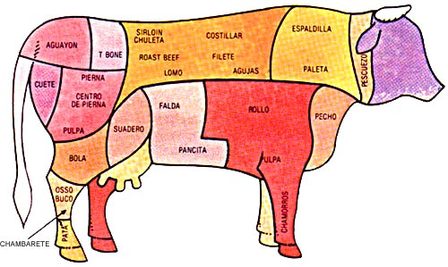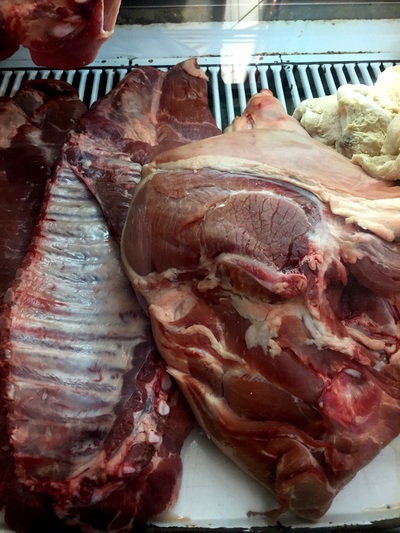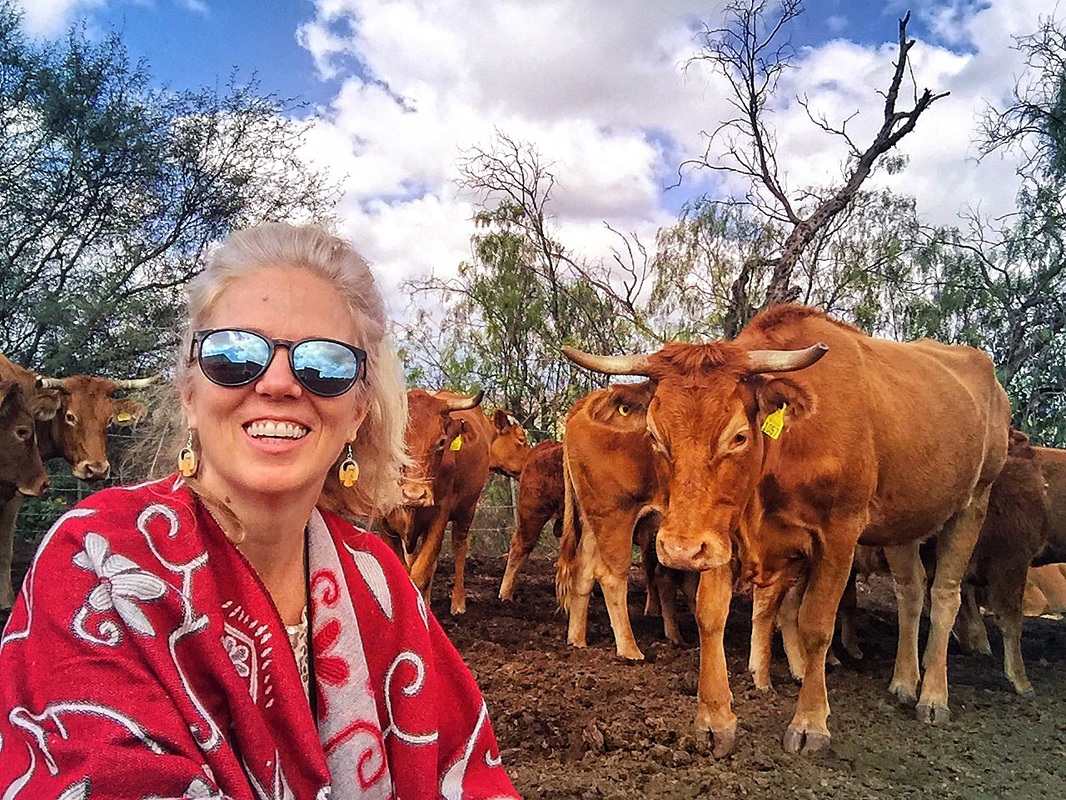|
What's your experience with shopping for and eating meat in San Miguel de Allende? I'm going to detail my experience, which is only based on my perceptions and opinions. I do not claim to know everything, as I am a visitor from a foreign, Trump-delusioned-land. My intention is to share my experience as I discover what it takes -- and what it means -- to produce clean meat in the middle of Mexico, where regulations are scare, and cultural traditions are steep. I invite you to share your experience with me if you like, together we can make sense of this! From what I can tell, there are many ranches in the State of Guanajuato that are raising grass-fed cattle; it's the natural and original way of raising cattle. Many of these ranches also have access to non-GMO grains, because they grow these grains on their properties, with local seeds -- although make no mistake; Monsanto is here and will continue to lean in hard (interesting video below). However, right now it is possible to find non-GMO seeds and grains, but it requires attention. Basically, all the cows we see from our cars as we drive through the countryside, whether here or abroad, are all enjoying a grass-fed life, and locally, they're probably enjoying some supplemental grains -- which cows love. Sounds idyllic, right? Healthy, happy cows, enjoying a life on the wide open craggy grasslands of the high Mexican desert. That's what I want, perhaps you do to. Then where does it go wrong -- or does it even go wrong? Ahhhh, wait for it.  Many of the ranchers are families with not much land, livestock and resources. This is the high desert, and food, nutrition and livelihood are real issues; I happen to have found myself in an opportunity with a Texan with a hobby ranch, but many Mexicans are living very close to the earth and having difficulties keeping next generations interested in farming, with good reason. The social economic issues are deep in Central Mexico, however, my focus is on meat production and what ends up on your plate when you live in San Miguel de Allende, so I will stick to this arena. And cut it out with a hobby ranch! There are meat producers who scour Guanajuato, looking for cattle to purchase for meat. Much of this meat is for tacos. Generally speaking, the practice is to search Guanajuato for a cattle rancher who is low on resources and perhaps low on hope. The producers offer a price much lower than market prices, but the ranchers are hungry and eager to sell, so often times the rancher will take the low ball offer and be done with it. The producers then move the cattle to backyard ranches, where they will beef up the animals with growth hormones (clenbuterol is widely used and seriously bad) and other steroids to increase the bulk and weight of the animal (and the chemical waste from the cattle are probably in our water supply), before they are sold to butchers and sent off to the slaughterhouse. Once the animal is sold for processing, it is sent to the city-owned slaughterhouse, called the "rasto" for sacrifice, and the process is shrouded in mystery, but more on that later. It costs $380 pesos to have an animal slaughtered, and unless you are prepared immediately to pick up the head, tongue, heart, lungs and intestines, the rasto will keep all these pieces and move it through the marketplace. We currently send a local from Dolores Hidalgo to the rastro with some tubs to pick up the guts, and they are immediately delivered to the taco guys in Dolores. I hope to be better prepared in the future to handle these pieces and make them available in San Miguel, but ultimately I am interested in making sure everything gets put to good use. No waste at all; we've sacrificed an animal. Each butcher has a rastro-issused password, and once the animal has been slaughtered, skinned and quartered, it is ready for pick-up by the butcher. Generally speaking, when the butcher receives the carcass, it is normally processed for immediate availability. There is very little dry aging; refrigeration is a premium and culturally speaking, the meat is ready for consumption as soon as it's processed. The meat is cut somewhat different here than in the States, which is why many times the meat in butcher shops looks so foreign, even though it comes from generally the same animal. Also, practically every spec of fat is traditionally removed too; the finishing process has not produced a nice fat, like the marbeling we are accustomed to in the States, so it is all removed. Once I learned this, it made sense why the butcher shops here look like the Texas Chainsaw Massacre; the hunks of meat for sale are fleshy, without fat and very bright red. My experience thus far has been with the neighborhood butcher shops, not the big chain grocery stores that are here, more on that later. I also know there are wonderful, friendly butchers in San Miguel, who are happy to work with their customers to provide you with any cuts; this is why it really pays to get to know your butcher! I even created an infographic on the subject: Anyone who lives in Mexico understands that herding cats would be a million times easier than the regulation or policing of anything. Clean meat production is very much in the pioneering stages, yet no where near the red-tape organic-proving nightmare of the United States. Many people in San Miguel de Allende believe their meat is "clean" (free of chemicals, added hormones and antibiotics) because things look "primitive"; please don't let this fool you, most meat is full of all the added chemicals the cows in the northern part of the continent get, and sometimes right up until it's time to slaughter -- which is big no-no.
The organic and slow food movement is here and will get louder and more populated, as it should. Currently, there are two local ranches producing grass-fed beef (not organic) in San Miguel; our Rancho Santo Niño and Cañada de la Virgen. I suspect these options will expand in the future, and best to stay in touch with local shops (Bodega Organica, Natura SMA and Via Organica) and the Saturday TOSMA Organic Mercado for more information. Its very exciting to be a part of this growing pioneering community and will continue with meaty updates. Thank you for your support!
5 Comments
Let me first start by stating that I am not a meat expert, nor a cow expert, nor a long-time cattle rancher, but I do have a passion for Rancho Santo Nino, its Limousin cows and the process in which these animals live their lives to eventually serve the community by providing grass-fed beef. My Spanish is not great either, bordering on bad, but about a year ago the idea of producing 100% grass-fed beef for the San Miguel de Allende community presented itself, and I have thrown myself into all areas of discovering what it takes to make good, clean meat. From slaughter to sales, I am involved in step of the process.
Once a long-time suffering vegetarian (ate too much cheese, probably, bread too) and even tried a stint as Meagan the Vegan when I lived in San Francisco, but this never fared well on me and I recall my doctor grabbing me by the shoulders and telling me I needed to eat a steak. I did and my return to meat was glorious! However I continued to waver back-n-forth; to meat or not to meat, that was the question. I tried the Atkins diet in the 90's -- holy Toledo that was horrible and I never felt more weighted down in my entire life. Most recently I was dealing with some stressful auto-immune issues, which led me to begin eating only organic and grass-fed meat, along with the good, hearty, organic vegetables that are wildly available in Central Texas, Home of Whole Foods Market and numerous farmer's markets. My health improved tremendously when I went on a solid paleo-type diet; I was perky once again, as well as quite content to have allowed myself permission to eat meat again sans guilt. I found my groove and I was committed to it. In mid-2015, I returned to Central Mexico, where there is no Whole Foods Market, but there is a growing and passionate real-food/slow-food community. Organic resources are on the rise for sure, but clean meat was hard to find. It was being trucked in from the Mexican state of Vera Cruz. Vera Cruz!? Guanajuato is the agriculture bowl of Mexico, yet there was no clean meat to be found. I then overheard Reed Burns, a blustery Texan with a cattle ranch in Dolores Hidalgo AND my one-time husband, on the phone attempting to sell his cattle to Mexico's version of a factory farm in Northern Mexico. I asked why would you send the cattle away like that, when we need clean meat right here??? He told me he didn't have time for that and said, "I'll give you a cow and you go figure it out." With a big burst of gusto, I have been figuring it out and I hope t be always figuring it out. The next day after that conversation with Reed, I was in Via Organica, speaking to them about grass-fed meat and they were thrilled to discover they could get it locally. We now sell our meat in their tienda and they use our meat in their restaurant. I look forward to continuing to work with them; they are a diverse and passionate group of people who are interested in clean food, and a visit to their organic ranch to see their operation and discover their educational programs is well worth the journey. And so it begins! Thank you for your support. |
Meagan BurnsProducer of Grass-fed Beef at Rancho Santo Nino ArchivesCategories |







 RSS Feed
RSS Feed